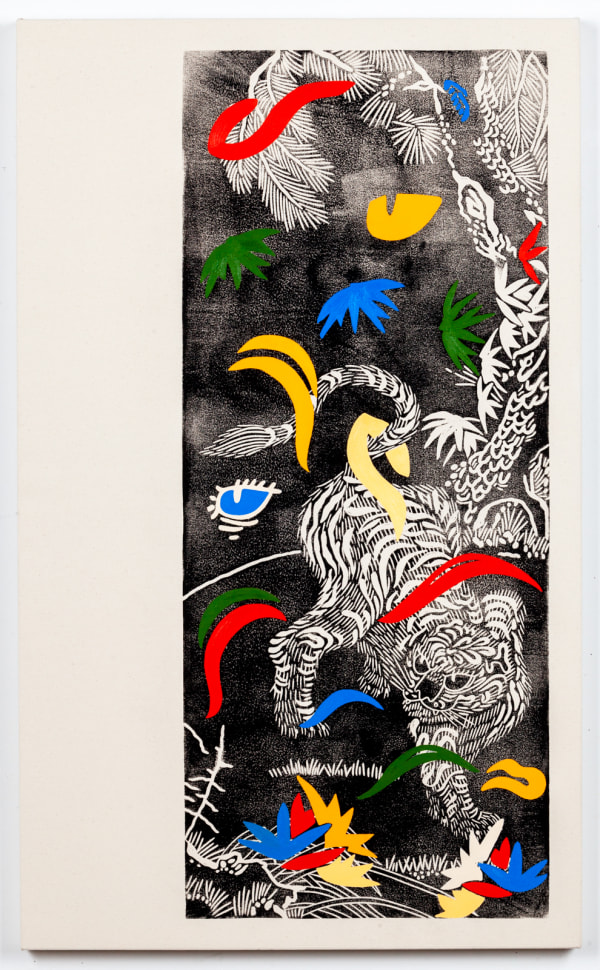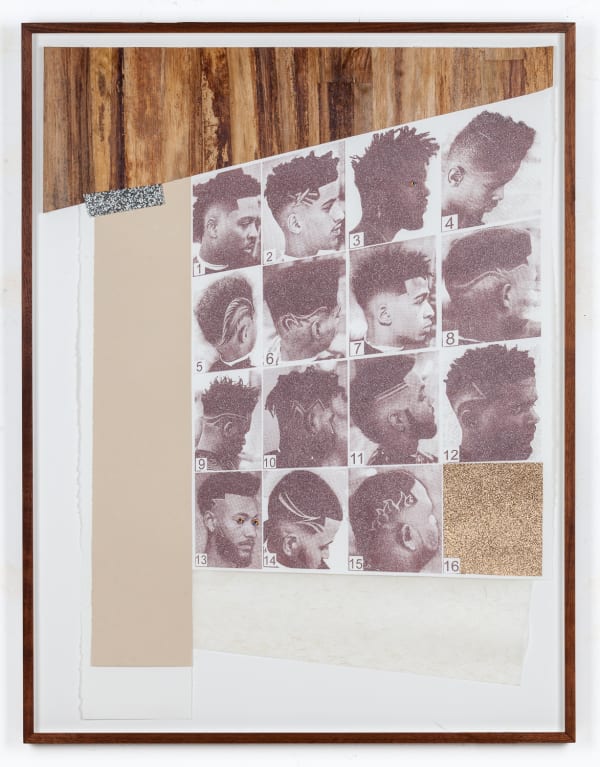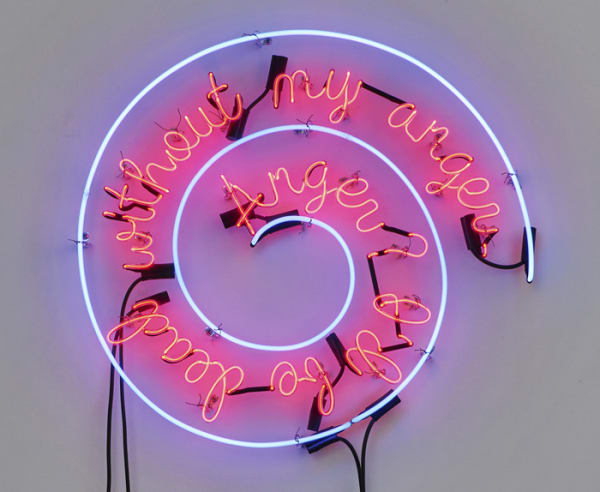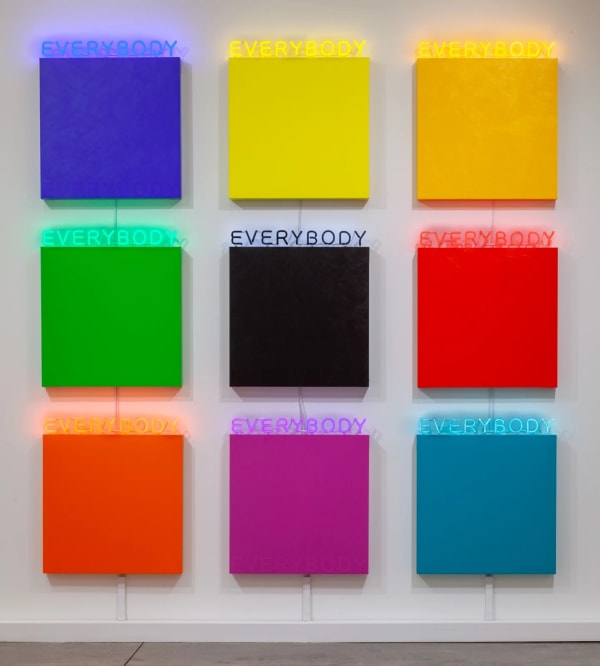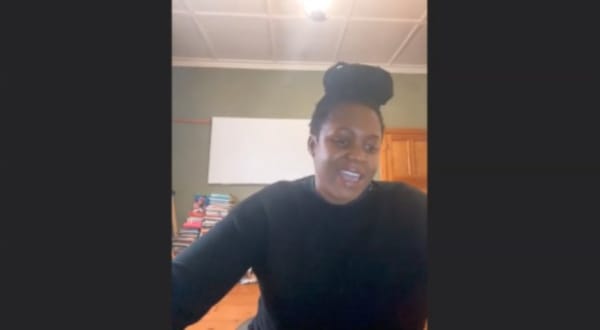-
-

For Frieze New York 2021, Kavi Gupta presents an online exhibition highlighting key works from some of today’s most influential contemporary artists. Recent works by Deborah Kass, Devan Shimoyama, and Beverly Fishman join a tightly curated selection of essential works from the oeuvres of Richard Hunt, Roger Brown (1941−1997), Clare Rojas, Michael Joo, and Young-Il Ahn (1934−2020).
We are also proud to present a selection of new works debuting in our upcomming shows from some of today’s most dynamic emerging artists—Allana Clarke, Basil Kincaid—and internationally recognized artists—Kour Pour, whose exhibition Familiar Spirits is currently on view at Kavi Gupta | Washington Blvd.; Manuel Mathieu, whose exhibition Negroland: A Landscape of Desires is currently on view at Kavi Gupta | Elizabeth St.; and Mary Sibande, whose exhibition Unhand Me, Demon! will inaugurate our new street-level gallery space at Kavi Gupta | Washington Blvd.
This presentation of both new and rarely seen classic works highlights the aesthetic and conceptual diversity within our program.

A central strand of Frieze New York 2021 programming is the Tribute to the Vision & Justice Project and its founder, Sarah Elizabeth Lewis (Associate Professor at Harvard University). The Tribute will honor the exemplary work of the Vision & Justice Project, through an unprecedented engagement with the community of galleries participating at Frieze New York at The Shed and Frieze Viewing Room. Discover the full program.
In conjunction with Frieze New York 2021, join us on Saturday, May 8, for an online conversation between Haitian-born, Montreal-based artist Manuel Mathieu and philanthropist and art collector Pamela Joyner, examining Mathieu's new works and the inspiration behind his latest exhibition with Kavi Gupta.

Left: Manuel Mathieu. Photo: Jessica Plautz. Right: Pamela Joyner. Photo: Drew Altizer
Manuel Mathieu is known for multimedia works that investigate themes of historical violence, erasure, religious symbolism, nature, and the various futures made possible by the act of remembering. He earned his MFA from Goldsmiths, University of London, in 2016. Recent solo exhibitions include World Discovered Under Other Skies, The Power Plant, Toronto (2020); Survivance, Montreal Museum of Fine Arts, Montreal (2020); and Manuel Mathieu: Nobody Is Watching, Kavi Gupta, Chicago (2018). A publication documenting the exhibitions at The Power Plant and the Montreal Museum of Fine Arts is forthcoming. This year Mathieu has been invited to the artist residency at the Art House in Sonoma, CA.
Pamela J. Joyner has nearly 30 years of experience in the investment industry. She is the Founder of Avid Partners, LLC, where her expertise has been the alternative investment arena. Currently, Ms. Joyner is focused on her philanthropic interests in the arts and education.
Ms. Joyner is a Trustee of the Art Institute of Chicago, the J. Paul Getty Trust, SF MoMA, and Tate Americas Foundation, as well as a member of the Tate North America Acquisitions Committee. She also serves on the Committee on Painting and Sculpture of The Museum of Modern Art. In the education arena, Ms. Joyner serves on the board of the Art & Practice Foundation.
Previously, Ms. Joyner’s philanthropic involvements have included serving as a member of President Obama’s Committee on the Arts and Humanities; a Trustee of Dartmouth College; a Trustee of the New York City Ballet; a Trustee and Co-Chair of the San Francisco Ballet Association; a Board Member of the MacDowell Colony; as well as other arts and educational organizations.
Saturday, May 8, 3pm CST on Zoom
-
While Manuel Mathieu (b. 1986, Haiti) has developed an aesthetic trajectory that may be easily traced to his Haitian upbringing, his work articulates his positionality from a multitude of realities and perspectives. Reposing on his own multiplicity, the abstractness of his work conveys the abundance in existing at the intersection of racial, geographical, and cultural identities.
Mathieu’s abstract imagery taps into the unrepresentable and elusive—he offers emotional and spiritual nuances that post-structuralist critiques neglect. He presents historical paintings that rely on emotive and speculative thinking as a form of knowledge production. He abandons figurative or didactic western traditions for a more interactive mode of interpretation where the viewers are actively participating in formulating their understanding of the work.
-
This work is emblematic of Kour Pour's (b. 1987, UK) signature method of creating a large-scale, unique block print and then adding painted or collaged elements on top of the print. This piece is one of the first in Pour's recent series of tiger paintings. The term "White Tiger of the West" relates to one of the four Chinese constellation symbols. It represents the direction west, not the West in cultural terms. It also represents the autumn season.
Similar to his renowned Carpet paintings, which integrate visual elements from pre-Victorian Persian carpets, these tiger paintings contain elements that reference both global art history and various interconnected cultural iconographies. The central motif in this new body of work is a tiger, an image immediately suggestive of a range of art historic and craft traditions, but which is also a personal reference for Pour.
Some artists use words like appropriation or re-mix to describe the process of activating existing visual associations from art history and contemporary culture in their work. Pour prefers to use the word foster.
-
These works were exhibited only once, in 2013. They represent an extraordinary glimpse into a crucial moment in the development of a rare talent. In the early 2010s, after taking a break from painting to refocus the intentions of her practice, Clare Rojas (b. 1976, USA) entered a period of fruitful experimentation that culminated in her transition from folk-inspired figuration to abstraction. This period resulted in the creation of the stunning body of abstract paintings documented in her monograph Plain Black: Abstract Paintings by Clare Rojas. Timeless and whimsical, the Plain Black paintings mark the formative stage of Rojas' shift towards plasticity as content: an evolution in style which saw her flat, colorful, abstract forms take on an almost narrative emotional presence. They signify a groundbreaking time when Rojas first mapped the liminal space between geometric and biomorphic abstraction, defining the distinctive visual language she employs today. All but a handful of the works documented in Plain Black have already been placed in private or institutional collections.
-
-
Towards the end of his life, Roger Brown (1941-1997) regularly started spending time in Southern California, having commissioned Stanley Tigerman to design him a home that we would call his "Temple of Painting" in La Conchita, California. Inspired by the landscape and character of the American Southwest for much of his adult life, the change of scenery was uplifting to Brown's spirit as his health declined due to complications from living with HIV/AIDS. This simple but elegant painting documents the California wildrose, scientifically known as rosa californica. Similar to his legendary late-career Bonsai paintings, this piece sees the wildrose dwarfing the human figures in the composition, despite being a fairly small flower. The magnificence of landscape, including rolling hills and whorls of clouds in harmony with the wildrose's branches, overwhelms the human figures and leaves them as only a footnote to the painting as a whole, perhaps a commentary from Brown on human impermanence when compared to the magnitude of the natural world.
-
Beverly Fishman (b. 1955, USA) employs a variety of techniques to explore technological, scientific, and biological systems of perception and representation, instigating constructive conversations about the ways people see their bodies and minds and form their identities. Her most illustrious works engage with the visual language of the medical industrial complex. Her highly polished Pill Reliefs utilize pharmaceutical forms as the basis for seemingly abstract compositions that radiate with color.
-
Mary Sibande (b. 1982, South Africa) is a sculptor, painter, and installation artist whose work not only engages as an interrogator of the current intersections of race, gender, and labor in South Africa; but continues to actively rewrite her own family’s legacy of forced domestic work imposed by the then-Apartheid state.
Through photography and sculpture, Sibande employs the human form as a vehicle for a focused critique of stereotypical depictions of women, particularly Black women in South Africa. For Sibande, the body is the site where history is contested and where Sibande’s own fantasies can play out. This counter-history takes the form of an alter-ego in Sibande’s early work, a persona by the name of ‘Sophie,’ whom Sibande dresses in various uniforms that resemble the dresses worn by domestic workers. Altering these dress styles into Victorian motifs, Sibande reanimates Sophie’s history through how her body is adorned and the way she occupies these narratives that were stolen and denied from her. This is not just a political act, but one of transformation, as Sophie takes on new incarnations of herself unbound from the labored history of servitude, as it relates to the present in terms of domesticity. Transitioning from blue to purple to red, Sibande introduces us not only to the many faces of herself and Sophie, but to the complex personhoods of African women who continue to create worlds and narratives outside of the canon of Western imperialism.
-
Basil Kincaid (b. 1986, USA) is a St. Louis-based post-disciplinary artist. Kincaid explores the fixity of conditioned and self-imposed constructs. Through quilting, collaging, photography, installation, and performance done with found, salvaged, and donated materials Kincaid interrogates social mores while drafting alternative cultural fabrics. With an improvisational and community-oriented approach, resourcefulness and freedom of imagination emerge as critical components in the liberation of spirit. Kincaid’s work can be seen in conceptual terms as an examination of two big ideas: reclamation and heritage. Reclamation is partly about acknowledging what has been cast off by people as part of the ordinary processes of living everyday life, and partly about discovering new value in what has outlived its previous uses. By finding new meanings and purposes for the cast off materials of society, Kincaid engages in the creation of new forms and experiences.
-
Devan Shimoyama (b. 1989, USA) is a visual artist whose work explores depictions of the Black, queer, male body. Through the medias of painting, sculpture, printmaking, and installation, he creates compositions inspired by classical painters, such as Francisco Goya and Caravaggio. However, Shimoyama's use of materials is distinctly contemporary, as is the subject matter he depicts. He has stated that he wants the figures in his work to be perceived as “both desirable and desirous.” He is aware of the politics of queer culture, and the ways in which those politics relate to Black American culture. These elements come together in his works in a way that is both celebratory and complicated.
Shimoyama says of his Hoodie series: "Each hoodie that I’ve made is part of an ongoing body of work in which I use materials that reference spontaneous memorials to adorn and embellish to cover the surface of a hoodie. These works pay homage to black youth whose lives have been taken from them, without any sort of justice being made post mortem. The hoodie became somewhat of an emblem for black males in a multitude of ways, and I really started to notice after the first image was widely being used of Trayvon Martin depicted him in a hoodie. While walking around my own neighborhood in Philadelphia where I grew up, I noticed signs saying that hoodies were no longer allowed to be worn in schools, as they had become associated with dangerous individuals, and therefore could risk violence being incited upon anyone wearing one. They would be vilified and criminalized based on an article of clothing."
-
-
Under Your Watchful Eye is part of a series of 14 new works by Trinidadian-American artist Allana Clarke (b. 1987, West Indies) called As the Ground. The series expands upon Clarke’s newest body of sculptures, through which Clarke expresses struggle and ritualistic transformation through performative gestures embedded in sculptures made from hair bonding glue.
The title of this piece relates to its final form, which is circular, with deep undulations in the draping. Clarke says it reminded her “of a vortex, and an eye.” Thinking about this idea of looking into the work, being pulled into it, and also of not being able to consume the entire work at once because of the innumerable folds and creases and shadows. “These pieces become very much about looking, on a micro and macroscopic scale,” says Clarke, “because there’s so much to discover, and so much unfolds the longer you spend with the work.”
A liquid latex commonly used to adhere hair extensions onto a person’s scalp, the hair bonding glue Clarke uses is sold in small, 8-ounce bottles over the counter from beauty supply stores. Clarke begins her sculptural process by pouring the hair bonding glue from the small bottles onto panels made of window screen. The bonding glue begins curing from the top, while remaining supple underneath for days or even weeks. During that time, Clarke manipulates the material by scraping it, pulling it, twisting it, and pushing into it with her entire body. This performative process of molding the material through her physical actions manifests as a sculptural relic of the artist literally grappling with her complicated relationship with her medium.
-
Deborah Kass (b. 1952, USA) first sketched DON’T STOP immediately after watching the finale of The Sopranos. Tony picks Journey’s “Don’t Stop Believin’” on the jukebox as a possible assassin in a Members Only jacket walks out of the bathroom towards him, à la Michael Corleone in The Godfather. Kass knows, of course, the words are also in Michael Jackson’s “Don’t Stop ’Til You Get Enough” and countless other pop songs. Yet, it wasn’t until the Trump era that she actually felt compelled to make these enlarged, neon versions of the piece. The phrase was something of a mantra to herself, about not giving up DESPITE the overwhelming tragedy that is the Trump presidency.
This painting is part of Deb Kass' No Kidding series (2015–present). One of the defining elements of this series is the incorporation of neon into the paintings. No Kidding deploys the aesthetic formalism of post-war abstraction, as did her feel good paintings for feel bad times. But now the mood has changed. The palette has shifted to dark colors and the surfaces of the paintings are worn and washed out. Seemingly positive lyrical phrases such as "Happy Days Are here Again" and "We'll Be Young Forever" contrast with a sense that everything is not alright. The colors and text in the works reference issues like women's health, climate change, and institutional racism. Among the most potent pieces in the series use the words and colors Black and Blue, alluding to, among other things, police violence against people of color.
-
Born near the infamous steel yards on the South Side of Chicago, Richard Hunt (b. 1935, USA) was delivered into a world of metal. As a young artist studying at the School of the Art Institute of Chicago in the 1950s, he perceived a Surrealist dreamworld lurking in the junkyards of Midwestern America. The cast-off, metal skeletons of the Steel Age—even then beginning to corrode in heaps across the Rust Belt—became lifelike abstractions in his hands, perfectly expressing the beauty and terror of a rapidly changing, mid-20th-century American Dream.
Hunt is one of the most accomplished American metal sculptors of the past century. His work has been exhibited 12 times at the Museum of Modern Art in New York, including a solo retrospective in 1971, when the artist was only 35 years old. Titled The Sculpture of Richard Hunt, March 25–July 9, 1971, it was only the third solo exhibition for a Black artist in the history of MoMA. The director of that show referred to it as a “mid-career” exhibition; however, Hunt is still active in his studio today.
-
Young-Il Ahn (b. 1934, Gaeseong, Korea; d. 2020, Los Angeles, CA) developed a distinctive oeuvre defined by meticulous, abstract paintings that explore his relationship with beauty, nature, and music. Ahn’s most famous body of work, the Water series, has been associated with Dansaekhwa, an aesthetic position specific to Korea characterized by the expression of natural processes through a monochromatic palette.
After relocating to Los Angeles in 1966 Ahn went on frequent long fishing trips in the waters between between Santa Monica and Catalina Island. On one such trip, he had the harrowing experience of becoming lost in a dense fog. When the fog finally lifted, the sea around him was calm and shimmering. Ahn wrote of that moment in his autobiography, And still it flows towards me: “My favorite colors from nature stretched to infinity. The sunlight crashed and reflected against the water every moment, dispersing splendid and sparkling colors in layers.” The experience inspired Ahn to create his Water series, on which he worked for over 30 years, until his death.
-
This painting belongs to Michael Joo's (b. 1966, USA) Various Low Mass Stars series of silver-nitrate paintings, which was derived from squatted architectural ruins and created in situ by exposure to the elements over the course of several days. The series examines how site is a place for encounters as well as explorations, and how time and absence affect representation and reality.
“For me, these works deal with the origins of painting not merely as something plastic, but as fragile, frozen moments emblematic of encounters at the intersection of time, material, and process,” says Joo. “It’s always the marriage of meaning and material that interests me—how we get there, and what possible other avenues of meaning we might find within our expectations of and responses to objects and each other.”
-
Get to know our artists
-

Art in Lockdown: Manuel Mathieu
-

Manuel Mathieu, Negroland: A Landscape of Desires
Kavi Gupta | 219 N. Elizabeth St. Chicago, IL 60607 24 April - 3 July 2021'There is no ground of alternatives but to recover the 'dangerous' chasm, the 'forbidden' ascent and seek a new dimension of feeling – a new oath of humanity.” – Wilson... -

Deborah Kass in conversation about Painting & Sculpture
September 12, 2020Deborah Kass in conversation with Kavi Gupta Museum Liaison Phillip Barcio about her new solo exhibition. -

Art in Lockdown: Devan Shimoyama
May 12, 2020Art in lockdown interview with Devan Shimoyama -

Art in Lockdown: Mary Sibande
April 21, 2020Art In lockdown Interview with Mary Sibande -

Studio Stories — Kour Pour
-

Roger Brown, Hyperframe
Exhibition Video -

In Conversation: Michael Joo & Charles Gaines
April 9, 2021
-













